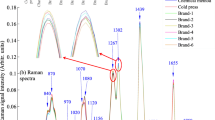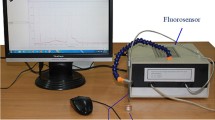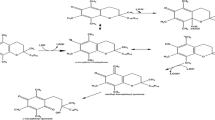Abstract
Fluorescence spectroscopy has been employed for the compositional analysis of flaxseed oil, detection of its adulteration and investigation of the thermal effects on its molecular composition. Excitation wavelengths from 320 to 420 nm have been used to explore the valued ingredients in flaxseed oil. The emission bands of flaxseed oil centred at 390, 414, 441, 475, 515 and 673/720 nm represent vitamin K, isomers of vitamin E, carotenoids and chlorophylls, which can be used as a marker for quality analysis. Due to its high quality, it is highly prone to adulteration and in this study, detection of its adulteration with canola oil is demonstrated by applying principal component analysis. Moreover, the effects of temperature on the molecular composition of cold pressed flaxseed oil has been explored by heating them at cooking temperatures of 100, 110, 120, 130, 140, 150, 160, 170 and 180 °C, each for 30 min. On heating, the deterioration of vitamin E, carotenoids and chlorophylls occurred with an increase in the oxidation products. However, it was found that up to 140 °C, flaxseed oil retains much of its natural composition whereas up to 180 oC, it loses much of its valuable ingredients along with increase of oxidized products.





Similar content being viewed by others
Data Availability
The datasets generated during and/or analysed during the current study are not publicly available due to commercially used samples but are available from the corresponding author on reasonable request.
References
Oomah BD (2001) Flaxseed as a functional food source. J Sci Food Agric 81:889–894
Fitzpatrick KC (2011) Health benefits of Flaxseed. Omega-3 oils. Elsevier, pp 213–264
Prasad K (2009) Flaxseed and Cardiovascular Health. J Cardiovasc Pharmacol 54:369–377
Shim YY, Kim JH, Cho JY, Reaney MJT (2022) Health benefits of flaxseed and its peptides (linusorbs). Crit Rev Food Sci Nutr 1–20
Ivanov S, Rashevskaya T, Makhonina M (2011) Flaxseed additive application in dairy products production. Procedia Food Sci 1:275–280
Kajla P, Sharma A, Sood DR (2015) Flaxseed—a potential functional food source. J Food Sci Technol 52:1857
Yakdhane A, Labidi S, Chaabane D et al (2021) Microencapsulation of flaxseed oil-state of art. Processes 9:1–16
Simopoulos AP (2002) The importance of the ratio of omega-6/omega-3 essential fatty acids. Biomed Pharmacother 56:365–379
Simopoulos AP (2008) The importance of the omega-6/omega-3 fatty acid ratio in cardiovascular disease and other chronic diseases. Experimental Biology Med (Maywood) 233:674–688
Hashempour-Baltork F, Torbati M, Azadmard-Damirchi S, Savage GP (2017) Quality Properties of Sesame and Olive Oils Incorporated with Flaxseed Oil. Adv Pharm Bull 7:97
Balić A, Vlašić D, Žužul K et al (2020) Omega-3 Versus Omega-6 polyunsaturated fatty acids in the Prevention and treatment of inflammatory skin diseases. Int J Mol Sci 21:741
El Makawy A, Eissa F, EL-Bamby M, Elhamalawy O (2018) Flaxseed oil as a protective agent against bisphenol-A deleterious effects in male mice. Bulletin of the National Research Centre 2018 42:1 42:1–9
Touré A, Xueming X (2010) Flaxseed lignans: source, biosynthesis, metabolism, antioxidant Activity, Bio-active Components, and Health benefits. Compr Rev Food Sci Food Saf 9:261–269
Tang ZX, Ying RF, Lv BF et al (2021) Flaxseed oil: extraction, Health benefits and products. Qual Assur Saf Crops Foods 13:1–19
Fojnica A, Leis HJ, Murkovic M (2022) Identification and characterization of the Stability of Hydrophobic Cyclolinopeptides from Flaxseed Oil. Front Nutr 9:1–13
Figueiredo PS, Candido CJ, Jaques JAS et al (2017) Oxidative stability of sesame and flaxseed oils and their effects on morphometric and biochemical parameters in an animal model. J Sci Food Agric 97:3359–3364
Patade A, Devareddy L, Lucas EA et al (2008) Flaxseed reduces total and LDL Cholesterol Concentrations in native American Postmenopausal women. J Women’s Health 17:355–366
Mercier S, Villeneuve S, Moresoli C et al (2014) Flaxseed-enriched cereal-based products: a review of the impact of Processing conditions. Compr Rev Food Sci Food Saf 13:400–412
Mohammadi-Sartang M, Mazloom Z, Raeisi-Dehkordi H et al (2017) The effect of flaxseed supplementation on body weight and body composition: a systematic review and meta-analysis of 45 randomized placebo-controlled trials. Obes Rev 18:1096–1107
Rabetafika HN, Van Remoortel V, Danthine S et al (2011) Flaxseed proteins: food uses and health benefits. Int J Food Sci Technol 46:221–228
Sun X, Zhang B, Han J et al (2022) Effect of roasting temperature and time on volatile compounds, total tocopherols, and fatty acids of flaxseed oil. J Food Sci 87:1624–1638
Waszkowiak K, Siger A, Rudzińska M, Bamber W (2020) Effect of roasting on Flaxseed Oil Quality and Stability. J Am Oil Chemists’ Soc 97:637–649
Zhang L, Chen J, Jing B et al (2019) New Method for the discrimination of adulterated Flaxseed Oil using Dielectric Spectroscopy. Food Anal Methods 12:2623–2629
Chen T, Chen X, Lu D, Chen B (2018) Detection of adulteration in canola oil by using GC-IMS and chemometric analysis. International Journal of Analytical Chemistry 2018:3160265
Yuan Z, Zhang L, Wang D et al (2020) Detection of flaxseed oil multiple adulteration by near-infrared spectroscopy and nonlinear one class partial least squares discriminant analysis. LWT 125:109247
De Souza LM, De Santana FB, Gontijo LC et al (2015) Quantification of adulterations in extra virgin flaxseed oil using MIR and PLS. Food Chem 182:35–40
Ali H, Saleem M, Anser MR et al (2018) Validation of Fluorescence Spectroscopy to Detect Adulteration of Edible Oil in Extra Virgin Olive Oil (EVOO) by applying Chemometrics. Appl Spectrosc 72:1371–1379
Saleem M (2020) Fluorescence Spectroscopy Based Detection of Adulteration in Desi Ghee. J Fluorescence 2020 30(1):181–191
Sikorska E, Khmelinskii I, Sikorski M (2019) Fluorescence spectroscopy and imaging instruments for food quality evaluation. Evaluation Technol Food Qual 491–533
Rabiej D, Szydłowska-Czerniak A (2020) Fluorescence and UV-VIS spectroscopy to Determine the Quality Changes of Rapeseed Oil Fortified with new antioxidant after Storage under various conditions. Food Anal Methods 13:1973–1982
Kongbonga YGM, Ghalila H, Onana MB et al (2011) Characterization of Vegetable oils by Fluorescence Spectroscopy. Food Nutr Sci 2:692–699
Saleem M, Ahmad N (2018) Characterization of canola oil extracted by different methods using fluorescence spectroscopy. PLoS ONE 13:e0208640
Saleem M, Ahmad N, Ali H et al (2017) Investigating temperature effects on extra virgin olive oil using fluorescence spectroscopy. Laser Phys 27:125602
Ahmad N, Saleem M (2018) Studying heating effects on desi ghee obtained from buffalo milk using fluorescence spectroscopy. PLoS ONE 13:e0197340
Binkley N, Harke J, Krueger D et al (2009) Vitamin K Treatment reduces undercarboxylated osteocalcin but does not alter bone turnover, density, or geometry in healthy Postmenopausal North American Women. J Bone Miner Res 24:983
Kyriakidis NB, Skarkalis P (2000) Fluorescence spectra measurement of olive oil and other vegetable oils. J AOAC Int 83:1435–1439
Grune T, Lietz G, Palou A et al (2010) Beta-carotene is an important vitamin a source for humans. J Nutr 140:2268S–2285S
Simpson KL (1983) Relative value of carotenoids as precursors of vitamin A. The Proceedings of the Nutrition Society 42:7–17
Huyan Z, Ding S, Liu X, Yu X (2018) Authentication and adulteration detection of peanut oils of three flavor types using synchronous fluorescence spectroscopy. Anal Methods 10:3207–3214
Lia F, Morote Castellano A, Zammit-Mangion M, Farrugia C (2018) Application of fluorescence spectroscopy and chemometric models for the detection of vegetable oil adulterants in Maltese virgin olive oils. J Food Sci Technol 55:2143–2151
Ntakatsane MP, Liu XM, Zhou P (2013) Short communication: Rapid detection of milk fat adulteration with vegetable oil by fluorescence spectroscopy. J Dairy Sci 96:2130–2136
Zhang T, Liu Y, Dai Z et al (2022) Quantitative Detection of Extra Virgin Olive Oil Adulteration, as opposed to peanut and Soybean Oil, employing LED-Induced fluorescence spectroscopy. Sensors 22:1227
Acknowledgements
The Authors would like to acknowledge Ms Fatima, scientific assistant at Agri. & Biophotonics Division NILOP, for support in recording the emission spectra and preparation of samples.
Funding
The authors declare that no funds, grants, or other support were received during the preparation of this manuscript.
Author information
Authors and Affiliations
Contributions
Muhammad Saleem conceived the concept, measured emission spectra, analysis, wrote the first manuscript; Dr. Naveed Ahmad prepared samples and reviewed the manuscript. Both authors read and approved the final manuscript.
Corresponding authors
Ethics declarations
Ethical Approval
Ethical approval was not needed because no human or animal was involved for conducting present study.
Competing Interests
The authors declare no competing interests.
Additional information
Publisher’s Note
Springer Nature remains neutral with regard to jurisdictional claims in published maps and institutional affiliations.
Rights and permissions
Springer Nature or its licensor (e.g. a society or other partner) holds exclusive rights to this article under a publishing agreement with the author(s) or other rightsholder(s); author self-archiving of the accepted manuscript version of this article is solely governed by the terms of such publishing agreement and applicable law.
About this article
Cite this article
Saleem, M., Ahmad, N. Fluorescence Spectroscopy Based Characterization of Flaxseed Oil. J Fluoresc (2024). https://doi.org/10.1007/s10895-024-03684-y
Received:
Accepted:
Published:
DOI: https://doi.org/10.1007/s10895-024-03684-y




